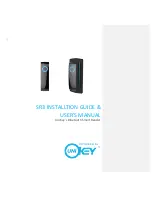
DSS2 T-BIS
– THE MICROPROCESSOR, TRIAC BASED SPEED CONTROLLER – MANUAL
v.2.6 / II-2017
DASKO Electronic ul. Do Studzienki 34B, 80-227 Gdańsk /Poland/ tel: (+48) 58 3459107
1/4
1.
DESCRIPTION
Microprocessor, triac-based speed controller for 1-phase motors
DSS2 T_BIS is available in two versions:
DSS2 T_BIS
– controlled by 0-10V analog signal (Fig.1)
DSS2 T_BIS_P
– controlled by 0-10V analog signal or keypad placed
on the facade (Fig. 2)
Fig. 1. DSS2 T-BIS_P
Fig. 2. DSS2 T-BIS_P
2.
APPLIANCE
The DSS2 ECO-1.5 speed regulators are designed for voltage speed control
of single-phase motors.
Typical motors suitable for voltage control:
motors with start up capacitor,
motors with work capacitor,
commutator motors.
WARNING!
1-phase asynchronous motors cannot be controlled by DSS2
T-BIS speed regulator. You should always make sure that the motor is
suitable for voltage control.
Typical DSS2 T-BIS applications:
air handling units and recuperator fans,
heating units fans (water heaters, electric heaters),
small electromechanical equipment, lighting, etc.
3.
TECHNICAL DATA
Table 1. Technical data of DSS2 T-BIS speed controller
MODEL
DSS2 T-BIS
DSS2 T-BIS_P
Supply voltage
230V / 50Hz
Max continuous current
5 A
Max peak current
8 A
Rated load
1,0 kW *
Steering
0-10 V signal
keypad / 0-10 V
IP protection level
IP 54
Mounting
surface / plate mounted
Signalling
–
on keypad
Steering type
Phase angle, triac
PWM frequency
50 Hz
Operating temperature range
-10÷50
o
C
Storage temperature range
-30÷60
o
C
0-10V analog input
Impedance of 25 kOhm, galvanically
isolated from the power supply
Additional voltage source
Supply source of 16 VDC, 15 mA
Housing material
ABS
Dimensions (HxWxL)
56x84x124 mm
Weight
410 g
* given power is an estimate - a key parameter for the selection of the
controller is the receiver’s current
4.
CHARACTERISTIC FEATURES
Smooth adjustment of the output voltage over the whole control
range.
Bimetallic contact motor protection control. Stop of work and alarm
indication.
Possibility to change the controller’s settings.
Adjustable output voltage depending on the setpoint of the keypad or
an external 0-10V signal level.
Possibility to combine multiple controllers in systems and control
them from a single point.
Compact, small and ergonomic design.
5.
INSTALLATION
The DSS2 T-BIS speed controller should be mounted horizontally on
the surface of a wall or in the control cabinet (in this case the
exchange of air or cooling should be made).
The power must be connected with non-shielded 3x1 mm² cable.
Steering signal must be connected by the shielded cable:
2x0.5 mm² – for steering by DEN 20, DEN30, PLC etc.
3x0.5 mm² – for steering by DEN 11.
The cable shield should be connected to G0 terminal.
The motor must be connected with the shielded 3x1 mm² cable.
The shield must be connected to the PE terminal and the motor
housing.
Cables must be completed with sleeves.
To connect the wires unscrew the four screws that secure the lid and
then perform the connection according to the diagram in Figure 4.
After connections are made, close the cover and switch the power
supply on.
The capacitor should be connected outside of the regulator.
The regulator provides an additional input to TK fan protection.
It must be connected by 2x1 mm² cable.
WARNING!
It is essential to disconnect the power before installing the
product.
It is forbidden to run the controller with an open case.
Installation should be performed by qualified personnel or the
service.
Non-authorised changes lead to warranty loss.
It is forbidden to disconnect the load (the motor) while operating.
By doing so you may damage the controller!
If the T5 fuse blows it is recommended to try to run a regulator
with an inserted F400 fuse and disconnected motor. If the fuse
does not blow - insert the T5 fuse and start the controller. If the
fuse blows again, please contact the manufacturer.






















